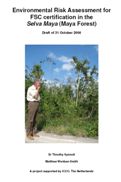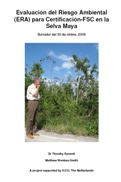 |
 |
Recent Work: ERA
|
 |
 |
|||||||
|
The Environmental Risk Assessment project was funded by ICCO, the Netherlands-based Interchurch Organisation for Development Cooperation.
ICCO’s mission is to work towards a world in which people live in dignity and prosperity, a world where poverty and injustice are no longer present. ICCO gives financial support and advice to local organisations and networks across the globe that are committed to providing access to basic social services, bringing about fair economic development and promoting peace and democracy. For further information visit ICCO's website
|
TOP Background Environmental Risk Assessment (ERA) can help identify which actions or activities are likely to be most important in relation to specified environmental outcomes. Management or monitoring effort can then be focussed on those actions or activities that are most significant. ERA techniques have been developed for the certification of fisheries where data may be missing or deficient (e.g. Hobday A.J (2006) Including a Risk-Based Component in the MSC Certification Process: a Solution to Data-Deficient and Small-scale Fishery Assessments. Marine Stewardship Council). In the context of forest certification ERA can help forest managers determine when detailed environmental monitoring is (or is not) justified, taking account of the scale and intensity of forest management, and the vulnerability of the forest resource. This project has developed an ERA for the Selva Maya (Maya Forest) of south-east Mexico, northern Guatemala and Belize, designed specifically to reduce the cost and increase the accessibility of Forest Stewardship Council (FSC) certification of community-managed forests in the region. However, the generic ERA system should be applicable in any region of the world, with relatively minor adaptations based on local expertise and testing. A second phase of the project proposes to adapt and test the ERA technique for use for FSC certification in other regions, including the Amazon basin, Congo basin and SE Asia. The project is still in progress. However the latest draft project report and ERA tools can be downloaded by clicking on the text in the right hand panel. Prototype ERA tool The ERA has been designed to be simple enough for use by any community forestry organization, but also to be sufficiently detailed, comprehensive and transparent to be accepted by certification organizations, NGOs and scientists. To achieve these conflicting aims, the ERA is designed as a checklist system based on the use of Microsoft Excel spreadsheets. A relatively high level of expertise is required in order to set the system up for a new region of the world, but once set up it can be used with little support by local community forest technicians. Minimum requirements to set the system up for a new region would be:
However, once the system has been set up for a specific region, its use is designed to be as simple as possible. Requirements for implementation are:
Our experience in the Selva Maya is that these requirements and skills are readily available to the community forestry organizations and their technical advisers, the intended primary users of the system, at no additional cost. Once the system has been set up for a region, it is used as follows: 1. The community managers tick boxes on a worksheet, providing basic information about their own forest management unit. For example, whether specified species are known to be present; what are the key harvested species of trees or Non-timber Forest Products; what is the general topography of the area; what kinds of soils are present. The terminology used has been designed to be readily understandable by community forest technicians with little or no external assistance. Our experience is that it should take about 10 minutes to complete this checklist. 2. The community managers specify a score of 0, 1, 2 or 3 for the 'scale' and 'intensity' of a list of previously specified stress factors. For example, managers would specify the intensity of harvesting of timber within the FMU as follows: low (score 1) medium (score 2) high (score 3) This is the most technically demanding aspect of the ERA implementation. It requires a sound knowledge of local management practices, as well as understanding of the terminology used to define the different levels of scale and intensity for the ERA. The terminology used has been developed and tested in the Selva Maya, and we believe it is readily understandable and usable by community forestry technicians in the region. Our experience is that it should take about one hour to complete this checklist. 3. The community forest managers tick boxes on the third worksheet, providing information about the presence or absence of specified 'mitigating measures', for example whether at least 10% of the FMU has been allocated to protected areas (yes or no). Completing this checklist should take about 10 minutes to complete. 4. Once the information described above has been entered, the system shows the results of the ERA on the 4th worksheet. The system has been set up to highlight (in red) environmental values which may be at risk, and the stress factors that are having the greatest impacts. 5. Using the results: If the ERA results show that some environmental values may be at risk, the system can then be used interactively. The effects of reducing the scale and intensity of management or other risk factors, or introducing additional mitigating measures can be readily evaluated. Alternatively, the managers may decide to develop effective monitoring systems focusing on these environmental values, to establish the actual impacts of management, and either confirm the level of risk or show that, in practice, any impacts are at an acceptable level. We would expect forest managers to decide the best course of action taking account of the costs of monitoring compared to the costs of mitigating their management practices. We recommend that if the system is used in a new region it is set up through a consultative process including ecological experts and community forest managers, so that a broad range of local expertise and experience can be incorporated.
TOP Antecedentes La Evaluación del Riesgo Ambiental (ERA) puede apoyar la identificación de las acciones o actividades que son las más importantes para alcanzar los resultados ambientales especificados. El enfoque del manejo o monitoreo puede entonces centrarse en las acciones o actividades que tienen los impactos mas significativos. Los técnicos de la ERA han sido desarrolados para la certificación de industrias pesqueras en situaciones en que se falta data o en que las data son deficientes (p.e. Hobday A.J (2006) Including a Risk-Based Component in the MSC Certification Process: a Solution to Data-Deficient and Small-scale Fishery Assessments. Marine Stewardship Council). En el contexto de la certificación FSC la Evaluación del Riesgo Ambiental (ERA) puede utilizarse para determinar si el monitoreo ambiental es necesario o no, tomando cuenta de la escala y de la intensidad del manejo, y la vulneribilidad del bosque. Este proyecto ha desarrollado una sistema ERA para la Selva Maya del SE de México, del norte de Guatemala y de Belice, con fines especificamente de reducir el costo e mejorar el acceso para la certificación de FSC en los bosques comunitarios en la región. Sin embargo, el sistema genérico de la ERA debe ser aplicable en cualquier región del mundo, con adaptaciones relativamente menores, en base de pruebas, experiencias y habilidades locales. Se pretende realizar una segunda fase del proyecto, para adaptar y probar la técnica de la ERA en otras regiones, incluyendo la cuenca del Amazonía, del Congo y en el sur-este de Asia. ERA prototipo La ERA ha sido diseñado para ser lo bastante simple para usarse por cualquier organización forestal comunitaria, pero también para ser suficientemente detallada, comprensiva y transparente para merecer el aval de organizaciones de certificación, ONGs y científicos. Para alcanzar estas metas, la ERA se diseña como listas de control, basadas en hojas de cálculo de Microsoft Excel. La modificación e instalación del sistema en una nueva región del mundo requiere de una capacidad técnica relativamente alta. Sin embargo, una vez que el sistema se haya instalado, su uso es lo más sencillo que posible. Los requisitos mínimos para instalar el sistema para una nueva región serían:
Sin embargo, una vez que el sistema se haya instalado para una región específica, su uso el lo más sencillo que posible. Los requisitos para la puesta en práctica son:
Nuestra experiencia en la Selva Maya ha sido que estos requisitos y las habilidades son fácilmente disponibles a las organizaciones de manejo forestal comunitario y a sus asesores técnicos, previstos como los principales usuarios del sistema, sin ningún costo adicional. Una vez que el sistema se haya instalado para una región, se usa como sigue: 1. Los encargados del manejo forestal marcan las células en una hoja de cálculo, proporcionando información básica sobre su propia UMF. Por ejemplo, para indicar si las especies especificadas estén presentes; cuáles son las principales especies cosechadas de árboles o de no-maderables; cuál es la topografía general del área; qué clases de suelos están presentes. La terminología usada ha sido diseñada para ser fácilmente entendible por los técnicos forestales, con poco o nada de ayuda externa. Nuestra experiencia indica que debe tomar cerca de 10 minutos para terminar esta primera lista de control. 2. Los gerentes especifican un valor de 0, 1, 2 o 3 para la “escala” y la “intensidad” de una lista de los factores de estrés, previamente especificados. Por ejemplo, los encargados podrían especificar la intensidad de la cosecha maderable en la UMF como siguen: Intensidad baja (cuenta 1) Intensidad media (cuenta 2) Intensidad alta (cuenta 3) Éste elemento es técnicamente el más demandante en la operación de la ERA. Requiere de un buen conocimiento de las prácticas locales de manejo, así de un entendimiento de la terminología usada para definir los niveles de escala e intensidad para la ERA. La terminología ha sido desarrollada y probada en la Selva Maya, y creemos que es fácilmente entendible y usable por los técnicos forestales en la región. Nuestra experiencia indica que debe tomar cerca de una hora para terminar esta lista de control 3. Los gerentes marcan las células en la tercera hoja de cálculo, proporcionando información sobre la presencia o ausencia de las Medidas de Mitigación especificadas, por ejemplo si por lo menos 10% de la UMF ha sido designado como áreas protegidas (sí o no). Esta lista de control debe tomar cerca de 10 minutos para terminarse. 4. Una vez que esta información ha sido incorporada, el sistema muestra los resultados de la ERA en la cuarta hoja de cálculo. El sistema ha sido diseñado para mostrar (en rojo) los valores ambientales que pueden estar a riesgo, y los factores de estrés con los impactos más grandes. 5. Usando los resultados: Cuando los resultados de la ERA demuestran que algunos valores ambientales pueden estar en riesgo, el sistema puede entonces usarse en forma interactiva. Se pueden evaluarse fácilmente los efectos de reducir la escala o intensidad del manejo, o de otros factores de riesgo, o de introducir más medidas de mitigación. Los gerentes pueden decidir realizar unos sistemas de monitoreo eficaces, centrados en estos valores ambientales, para establecer los impactos actuales del manejo, para confirmar el nivel del riesgo, y para demostrar si los impactos tengan o no tengan un nivel aceptable. Se espera que los gerentes del bosque decidieran la mejor línea de conducta, tomando en cuenta los costos de monitoreo en comparación con los costos de mitigar sus prácticas de manejo.
|
    |
|||||||||
Home | Top
About Us | What We Do | Recent Work | Resources | Publications | Site Map | Contact Us